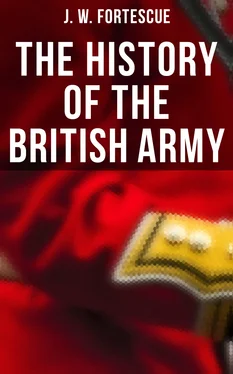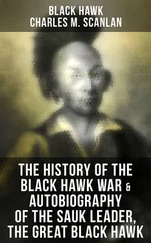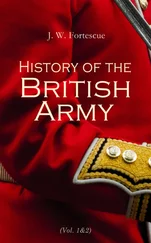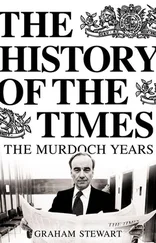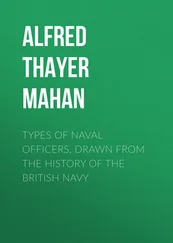The force was divided into large bands or battalions, of which the normal formation for battle was a wedge broadening out from a front of two men to a base of uncertain number; the officers and the better armed men forming the point, backed by a dense column of inferior troops. It was with a single line of such wedges, apparently from five-and-twenty to thirty of them, that Harold took up his position to bar the advance of the Norman army. Having no cavalry, he had resolved to stand on the defensive, and had chosen his ground with no little skill. His line occupied the crest of a hill, his flanks were protected by ravines, and he had dug across the plain on his front a trench which was sufficient to check a rapid advance of cavalry. Moreover, he had caused each battalion to ring itself about with sharp stakes, planted into the ground at intervals with the points slanting outwards, as a further protection against the attack of horse.[3] The reader should take note of these stakes, for he will find them constantly reappearing up to the seventeenth century. There then the English waited in close compact masses, a wall of shields within a hedge of stakes, the men of nine-and-twenty shires under a victorious leader. There is no need to enter into details of the battle. The English, as has been well said,[4] were subjected to the same trial as the famous squares at Waterloo, alternate rain of missiles and charges of cavalry, and as yet they were unequal to it. Harold's orders had been that not a man should move, but when the Normans, after many fruitless attacks, at last under William's direction simulated flight, the order was forgotten and one wing broke its ranks in headlong pursuit of the fugitives. Possibly, if Harold had been equal to the occasion, a general advance might have saved the day, but he made no such effort, and he was in the presence of a man who overlooked no blunder. The pursuing wing was enveloped by the Normans and annihilated; and then William turned the whole of his force against the fragment of the line that remained upon the hill. The English stood rooted to the ground enduring attack after attack, until at last, worn out with fatigue and choked with dead and wounded, they were broken and cut down, fighting desperately to the end. Indiscipline had brought ruin to the nation; and England now passed, to her great good fortune, under the sway of a race that could teach her to obey.
But the English had still one more lesson to learn. Many of the nobles, chafing against the rule of a foreigner, forsook their country and, taking service with the Byzantine emperors, joined the famous Varangian Guard of the Emperor Alexius Comnenus. At Durazzo they for the second time met the Normans, under the command of Robert Guiscard. True to their custom, they dismounted and fought on foot, a magnificent corps, the choicest of the whole army. As at Hastings, the Normans attacked and were repulsed, and as at Hastings, the undisciplined English broke their ranks in pursuit. Robert Guiscard saw his opportunity, hurled his cavalry on to their flank, and then surrounding them on all sides cut them down, in spite of a furious resistance, to the very last man. So perished these untameable, unteachable spirits, the last of the unconquered English.
The Conquest was immediately followed by the institution of knight-service. But this system, as introduced into England, differed in many material respects from that which reigned on the continent of Europe. It was less distinctly military in character, and far less perfect as an organisation for national defence. The distribution of England into knight's fees, however clearly it might be mapped out on paper, was a work of time and not to be accomplished in a day. Moreover, there was disloyalty to be reckoned with; for the English were a stiff-necked people, and were not readily reconciled to the yoke of their new masters. We find, therefore, that in very early days the practice of accepting money in lieu of personal service crept in, and enabled the Norman kings to fight their battles with hired mercenaries. For this reason England has been called the cradle of the soldier; the soldier being the man who fights for pay, solde , solidus , or, as we may say by literal translation of the Latin, the man who fights for a shilling.
The sole military interest therefore of the reigns of the Norman kings is to follow the breakdown of the feudal system for military purposes, and the rapid reversion to the Saxon methods and organisation. William Rufus was the first to appeal to the English to arm in his cause, and he did so twice with success. But in the seventh year of his reign he played them a trick which lost him their confidence for ever. The fyrd had furnished twenty thousand men for service against the Norman rebels in France, and had provided every man, at the cost of his shire, with ten shillings for the expenses of his journey or, to use a later expression, for his conduct-money. William met them at the rendezvous, took their two hundred thousand shillings from them to hire mercenaries withal, and dismissed them to their homes. This Rufus has been selected by an historian of repute as the earliest example of an officer and a gentleman; he should also be remembered as the first officer who set the fashion, soon to become sadly prevalent, of misappropriating the pay of his men. The reader should note in passing this early instance of conduct-money, for we shall find in it the germ of the Queen's shilling.
1106.
1116.
1125, 25th March.
The reign of Henry the First is interesting in that it shows us English knights serving in the field against Robert of Normandy under the walls of Tenchbrai. We find that the old order of battle, the single line of Hastings,[5] has disappeared and has given place to the three lines of the Byzantine school, but that, strange to say, the Saxons have forced their peculiar principle upon the Normans. Henry caused his English and Norman knights to dismount, formed them into a solid battalion and placed himself at their head, keeping but one small body still on their horses. The enemy's cavalry attacked Henry's mounted men and dispersed them; but the phalanx of the dismounted remained unbroken, pressed on against the rabble of hostile infantry, broke it down and almost annihilated it. The victory was hailed by the English as atonement for the defeat at Hastings, so bitter even then was the rivalry between ourselves and our gallant neighbours across the channel. Ten years later the English were again in France, fighting not only against rebellious Norman barons but against their ally, the French King Louis the Sixth. A long and desultory war was closed by the action of Brenville. Again Henry dismounted four hundred out of five hundred of his knights and following the tactics of Tenchbrai won, though not without hard fighting, a second victory. A third engagement, known as the battle of Beaumont, saw the old English practice repeated for the third time with signal success; but here must be noticed the entry of a new force, a company of archers, which contributed not a little to the fortunate issue of the day. For as the Norman cavalry came thundering down on the English battalion, the archers moved off to their left flank and poured in such a shower of arrows that the horsemen were utterly overthrown. These archers must not be confounded with the famous English bowmen of a later time, for most probably they were merely copied, like the order of battle, from the Byzantine model; but they taught the English the second of two useful lessons. Henry had already discovered that dismounted knights could hold their own against the impetuous cavalry of France; he now learned that the attack of horse could be weakened almost to annihilation by the volley of archers. This, at a time when cavalry held absolute supremacy in war, was a secret of vital importance, a secret indeed which laid the foundation of our military power. Henry, evidently alive to it, encouraged the practice of archery by ordaining that, if any man should by accident slay another at the butts, the misadventure should not be reckoned to him as a crime.
Читать дальше
